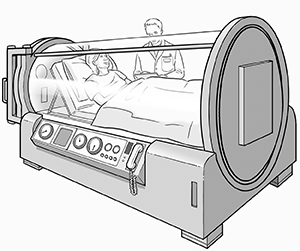Understanding Hyperbaric Therapy
Hyperbaric oxygen therapy (HBOT) is a treatment that is used most often to treat wounds that won’t heal. Wounds need oxygen to heal correctly. With HBOT, your body gets 100% oxygen at a pressure that is greater than normal. By exposing a wound to such a high oxygen level, the wound may heal faster. HBOT may also be used to treat conditions, such as diving decompression sickness. Studies are not clear that this treatment can help other conditions, such as severe carbon monoxide poisoning and certain infections.
Your healthcare provider will talk with you about HBOT. Each HBOT treatment can last from 45 minutes up to 2 hours. The length and number of treatments you need depend on the wound and how well the treatment is working.
Types of hyperbaric oxygen chambers
HBOT uses 2types of chambers:
-
Monoplace chamber. This is a chamber built for1 person. It's a long, plastic tube that is made out of a thick, clear acrylic glass. The patient goes into the chamber. Then it's slowly pressurized with 100% oxygen.
-
Multiplace chamber. This chamber, or room, can fit 2 or more people at once. With this type of chamber, the chamber is not pressurized with oxygen, but rather room air. Instead, the people breathe in 100% oxygen through masks or hoods.
Once in the chamber, it will be sealed and you will get the oxygen. Your blood carries the extra oxygen throughout your body. This extra oxygen fills the injured tissues that need it so they can start healing.

Why HBOT is done
HBOT is done to provide the body with high concentrations of oxygen to promote healing of chronic wounds. HBOT works in several ways.
-
It brings oxygen-rich plasma to tissues starved for oxygen. With a wound, blood vessels are damaged. As a result, fluid leaks into the tissues and causes swelling. This swelling doesn’t allow the damaged cells to get oxygen. Lack of oxygen causes the cells and tissue to die. HBOT raises the amount of oxygen in the blood. Tissues become flooded with oxygen. This reduces swelling. With less swelling, the cells are able to get more oxygen to do their job.
-
It prevents "reperfusion injury." After severe tissue damage, such as a crush injury, blood supply returns to the tissues after they have been left without oxygen. As the blood returns, the cells that were damaged with the injury give off harmful oxygen radicals. These radicals cause the blood vessels to clamp up. Blood flow stops and tissue is damaged even more. This damage can't be reversed. Substances in the body, called scavengers, seek out these radicals. HBOT promotes these scavengers to take care of the radicals and let healing continue.
-
It helps block the action of harmful bacteria and makes the body's immune system stronger. Certain bacteria form substances called toxins that damage the cells and tissues. HBOT can stop these toxins from doing damage. By raising the amount of oxygen in the tissues, the body is better able to resist infection. In addition, HBOT improves the ability of white blood cells to find and destroy invaders.
-
It encourages the body to make collagen and new skin cells. HBOT helps new blood vessels to grow. It also helps cells make certain substances, like growth factors. These factors aid in forming collagen and new tissues for healing.
HBOT may be used to treat the following wounds:
-
Radiation injuries
-
Infected wounds, such as gas gangrene
-
Burns
-
Certain skin grafts and flaps
-
Crush injuries, such as when a body part is squeezed between 2 heavy objects
-
Wounds from diabetes, such as nonhealing ulcers
How HBOT is done
Here is what likely happens during a hyperbaric oxygen therapy session:
-
You may be asked to remove your clothing and wear a medical gown that is 100% cotton.
-
You will be placed in the chamber.
-
If it's a monoplace chamber, you will lie on a table that slides into a clear plastic tube that’s about 7-feet long. A healthcare provider will be outside the chamber to check on you. You and the provider will be able to talk with one another throughout the treatment.
-
For a multiplace chamber, you can stand, sit, or lie down in the chamber. You will put on a mask or hood to get the oxygen. A healthcare provider will be in the chamber with you to check on you.
-
The chamber will be sealed and then oxygen will be given.
-
You will be asked to relax and breathe normally during the procedure.
-
The pressure will rise to 2.5 times the normal air pressure. Your ears may feel plugged as the pressure is raised. Swallowing or chewing gum can help “pop” the ears back to normal. You may also have mild discomfort. This is normal.
-
When your session is done, the pressure in the chamber will be lowered slowly.
-
You may feel lightheaded and tired. These symptoms often go away after a short time.
Risks of HBOT
Hyperbaric oxygen therapy is not for everyone. It shouldn't be used by people who have had a recent ear surgery or injury, a cold or fever, or certain types of lung disease.
Risks of hyperbaric oxygen therapy are rare but may include: